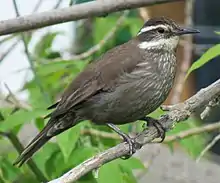Dark-bellied cinclodes
The dark-bellied cinclodes (Cinclodes patagonicus) is a species of bird in the family Furnariidae. It is found in Argentina and Chile. Its natural habitats are rivers and rocky shores. The dark-bellied cinclodes is distributed in Chile from about Santiago southwards to Tierra del Fuego and in adjacent areas of extreme western Argentina. It is found near streams, lakes and marshlands from sea level up to 2,500 m. It has a bold white supercilium and throat.
| Dark-bellied cinclodes | |
|---|---|
 | |
| Scientific classification | |
| Kingdom: | Animalia |
| Phylum: | Chordata |
| Class: | Aves |
| Order: | Passeriformes |
| Family: | Furnariidae |
| Genus: | Cinclodes |
| Species: | C. patagonicus |
| Binomial name | |
| Cinclodes patagonicus (Gmelin, 1789) | |
Description
The dark-bellied cinclodes grows to a length of about 20.5 cm (8 in). The upper parts are mainly a sooty brown, with a broad white superciliary stripe and pale buff tips to the outer tail feathers. The wings have buff wing-bars which are chiefly visible in flight. The chin, throat and sides of the neck are white flecked with dusky grey while the breast and belly are greyish-brown, with the breast streaked with white. The beak is charcoal grey and slightly curved and the rather short legs are dark grey.[2][3]
Distribution and habitat
This species is native to the southern tip of South America, its range extending from Valparaíso in Chile southwards to Tierra del Fuego and southwestern Argentina. In the northern part of its range it is found in the Andean foothills at altitudes of up to 2,500 m (8,200 ft), but further south, its altitudinal range descends to the sea. It is usually found near water, on lake shores, riverbanks, streamsides and on coasts.[2][3]
Ecology
Chilean seaside cinclodes often cock their tails as they walk. They forage singly or in pairs,[2] searching for the small crustaceans and other invertebrates on which they feed. Breeding takes place between September and December. The nest is built in such places as a rock crevice, a stone wall, an animal burrow, a tree hole or on a bridge girder, and is formed out of grasses, with two to four white eggs being laid.[3]
Status
The dark-bellied cinclodes has a very wide range and is described as fairly common. The population trend seems to be steady, and the total population is large. No particular threats have been identified and the International Union for Conservation of Nature has assessed the bird's conservation status as being of least concern.[1]
References
- BirdLife International (2012). "Cinclodes patagonicus". IUCN Red List of Threatened Species. 2012. Retrieved 26 November 2013.CS1 maint: ref=harv (link)
- Ridgely, Robert S.; Tudor, Guy (2009). Field Guide to the Songbirds of South America: The Passerines. University of Texas Press. p. 71. ISBN 978-0-292-71748-0.
- Chester, Sharon (2010). A Wildlife Guide to Chile: Continental Chile, Chilean Antarctica, Easter Island, Juan Fernández Archipelago. Princeton University Press. p. 248. ISBN 1-4008-3150-4.
